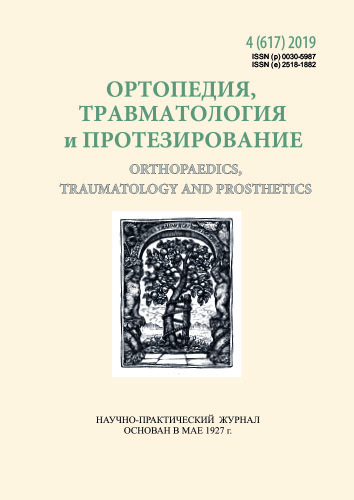Plantar aponeurosis features according to the results of anatomical research
DOI:
https://doi.org/10.15674/0030-59872019470-74Keywords:
plantar aponeurosis, plantar fasciitis, foot, linear dimensions, anatomical examinationAbstract
Objective: analysis of the results of plantar aponeurosis anatomy, clarification of its structural features and linear sizes. Methods: we studied the anatomy of plantar aponeurosis of the 20 fresh amputated lower limbs. The average age of patients (15 men, 5 women) was (53.5 ± 18) years old. Diseases that have become cause of amputations were oncological — 10, obliterating angiopathy — 5, consequences of injuries — 5. Using vernier caliper we measured the linear dimensions (mm) of the plantar aponeurosis: length, proximal and distal width, width of lateral and central bundles, thickness of the proximal aponeurosis and the lateral bundle. Average values were calculated. Results: plantar aponeurosis consisted of well-defined, longitudinally located bundles; fan-shaped expanded from the narrow proximal part with a width of (26.8 ± 5.4) mm to a wide distal — (71.9 ± 3.2) mm. Mid plantar length aponeurosis was (128.0 ± 16.8) mm. Thickness enthesis — (3.6 ± 1.9) mm. The medial bundle was not expressed and formed with the central one. Width of the central bundle amounted to (15.35 ± 1.50) mm. Lateral, thinner bundle, in 17 cases was well defined, its width was (11.75 ± 2.70) mm, thickness — (2.25 ± 1.06) mm. In three cases the lateral bundle was reduced from the calcaneus. Options for the absence of the lateral bundle were not detected. Conclusions: plantar aponeurosis — fan-shaped structure with shiny white color consists of well-defined, longitudinally located bundles. Three-beam plantar aponeurosis structures were not observed after moving away from the calcaneal tuber. The central bundle of the aponeurosis is the widest and thickest, thinner lateral was of varying severity, in three cases, gradually reduced. The medial bundle, which forms a single structure with the central bundle, turned out to be the most subtle and not expressed.
References
- Irving, D. B., Cook, J. L., Young, M. A., & Menz, H. B. (2008). Impact of Chronic Plantar Heel Pain on Health-Related Quality of Life. Journal of the American Podiatric Medical Association, 98 (4), 283–289. doi:10.7547/0980283
- Waclawski, E. R., Beach, J., Milne, A., Yacyshyn, E., & Dryden, D. M. (2015). Systematic review: plantar fasciitis and prolonged weight bearing. Occupational Medicine, 65 (2), 97–106. doi:10.1093/occmed/kqu177
- Tong, K. B., & Furia, J. (2010). Economic burden of plantar fasciitis treatment in the United States. The American Journal of Orthopedics, 39 (5), 227–231.
- Kalniev M. A., Krastev, D., Krastev, N. (2013). Abnormal attachments between a plantar aponeurosis and calcaneus. Clujul Medical, 86 (3). 200–202.
- Moore, K. L., & Dalley, A. F. (2010). Clinically Oriented Anatomy. Hardcover Edition (Point (LWW))
- Bojsen-Moller F., & Flagstad, K. (1976). Plantar aponeurosis and internal architecture of the ball of the foot. The Journal of Anatomy, 121 (3), 599–661.
- Wearing, S. C., Smeathers, J. E., Urry, S. R., Hennig, E. M., & Hills, A. P. (2006). The Pathomechanics of Plantar Fasciitis. Sports Medicine, 36 (7), 585–611. doi: 10.2165/00007256-200636070-00004
- Sarrafian, S. K. (2011). Anatomy of the foot and ankle: descriptive, topographic, functional. LWW.
- Chen, D., Li, B., Aubeeluck, A., Yang, Y., Huang, Y., Zhou, J., & Yu, G. (2014). Anatomy and Biomechanical Properties of the Plantar Aponeurosis: A Cadaveric Study. PLoS ONE, 9(1), e84347. doi: 10.1371/journal.pone.0084347
- Stecco, C., Corradin, M., Macchi, V., Morra, A., Porzionato, A., Biz, C., & De Caro, R. (2013). Plantar fascia anatomy and its relationship with Achilles tendon and paratenon. Journal of Anatomy, 223 (6), 665–676. doi: 10.1111/joa.12111
- Pontious, J., Flanigan, K., & Hillstrom, H. (1996). Role of the plantar fascia in digital stabilization. A case report. Journal of the American Podiatric Medical Association, 86 (1), 43–47. doi: 10.7547/87507315-86-1-43
- Hansen, L., Krogh, T. P., Ellingsen, T., Bolvig, L., & Fredberg, U. (2018). Long-Term Prognosis of Plantar Fasciitis: A 5- to 15-Year Follow-up Study of 174 Patients With Ultrasound Examination. Orthopaedic Journal of Sports Medicine, 6 (3), 232596711875798. doi: 10.1177/2325967118757983
Downloads
How to Cite
Issue
Section
License
Copyright (c) 2020 Olena Turchin, Anastasiia Hrygorovska, Pavlo Snisarevskiy, Andriy Lyabakh

This work is licensed under a Creative Commons Attribution 4.0 International License.
The authors retain the right of authorship of their manuscript and pass the journal the right of the first publication of this article, which automatically become available from the date of publication under the terms of Creative Commons Attribution License, which allows others to freely distribute the published manuscript with mandatory linking to authors of the original research and the first publication of this one in this journal.
Authors have the right to enter into a separate supplemental agreement on the additional non-exclusive distribution of manuscript in the form in which it was published by the journal (i.e. to put work in electronic storage of an institution or publish as a part of the book) while maintaining the reference to the first publication of the manuscript in this journal.
The editorial policy of the journal allows authors and encourages manuscript accommodation online (i.e. in storage of an institution or on the personal websites) as before submission of the manuscript to the editorial office, and during its editorial processing because it contributes to productive scientific discussion and positively affects the efficiency and dynamics of the published manuscript citation (see The Effect of Open Access).














